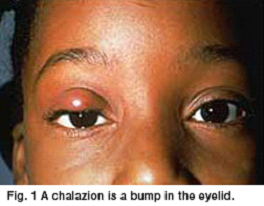Blockage of a gland of Zeiss or Moll causing a small inflamed cyst at the lid margin.

A chalazion is a localized bump in the eyelid of varying sizes. {See Figure 1]. More than one chalazion can occur in an eyelid at the same time, and both upper and lower eyelids may be affected. A chalazion can occur on one or both eyes.
Small glands lining the edge of the eyelids produce oil that helps lubricate the surface of the eye (meibomian glands). When one of these glands becomes blocked, oil backs up inside the gland and forms a bump in the eyelid. If the gland ruptures, the oily materials can irritate the surrounding eyelid skin causing it to become red, swollen and painful.
A chalazion is not exactly the same thing as a stye, although the terms are often used interchangeably. A stye, medically referred to as a hordeolum, is a bump in the eyelid that occurs when an oil gland becomes infected. It is like a small abscess or “boil” on the edge of the eyelid. A chalazion is an accumulation of material in the eyelid as a result of a blocked oil gland.
Usually there is no known underlying cause. However, chronic inflammation of the oil gland openings (blepharitis),predisposes to the development of a chalazion. Persistent blepharitis may result in recurrent chalazia. Blepharitis may be aggravated by poor eyelid hygiene that includes eye rubbing in children. Certain skin types may be more prone to chalazia and blepharitis.
Most chalazia resolve by themselves within several days to weeks, but sometimes can take months to completely disappear. Warm compresses over the affected area can promote drainage of the blocked gland. Anti-inflammatory eye drops, ointments or an injection into the bump may be needed. Oral antibiotics may be used if the chalazion is associated with bacterial infection of the surrounding eyelid tissues (cellulitis). A large, swollen, or persistent chalazion might require surgical drainage. Although older children and adults can undergo the procedure in a doctor’s office under local anesthesia, general anesthesia is usually necessary to drain chalazia in young children.
A consistent daily regimen of eyelid scrubs using baby shampoo or pre-moistened eyelid cleansing wipes can reduce the chances of developing new chalazia. This is especially useful when blepharitis is present. For those with a recurrent problem, regular use of topical or oral antibiotics is sometimes prescribed.
Reference: American Association for Pediatric Ophthalmology and Strabismus

